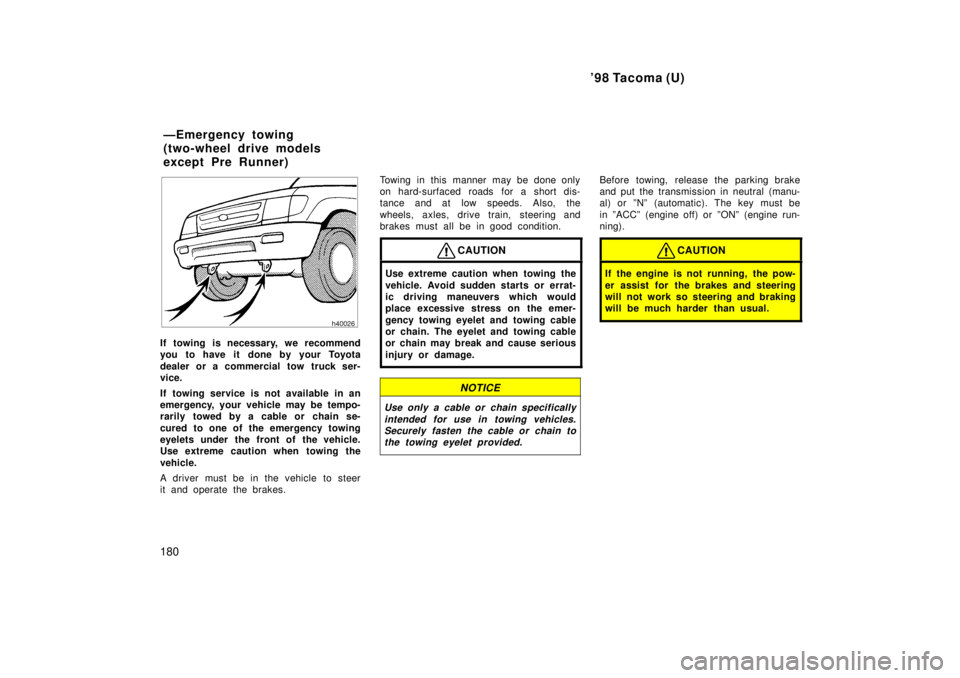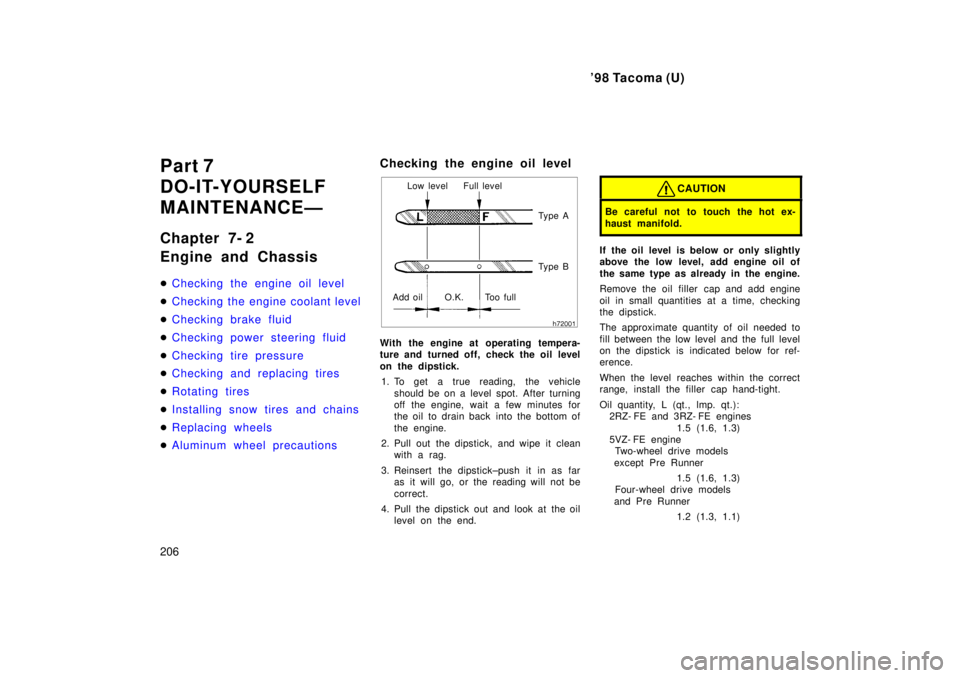1998 TOYOTA TACOMA steering wheel
[x] Cancel search: steering wheelPage 180 of 246

'98 Tacoma (U)
180
If towing is necessary, we recommend
you to have it done by your Toyota
dealer or a commercial tow truck ser-
vice.
If towing service is not available in an
emergency, your vehicle may be tempo-
rarily towed by a cable or chain se-
cured to one of the emergency towing
eyelets under the front of the vehicle.
Use extreme caution when towing the
vehicle.
A driver must be in the vehicle to steer
it and operate the brakes. Towing in this manner may be done only
on hard-surfaced roads for a short dis-
tance and at low speeds. Also, the
wheels, axles, drive train, steering and
brakes must all be in good condition.
CAUTION
Use extreme caution when towing the
vehicle. Avoid sudden starts or errat-
ic driving maneuvers which would
place excessive stress on the emer-
gency towing eyelet and towing cable
or chain. The eyelet and towing cable
or chain may break and cause serious
injury or damage.
NOTICE
Use only a cable or chain specificallyintended for use in towing vehicles.Securely fasten the cable or chain to the towing eyelet provided.
Before towing, release the parking brake
and put the transmission in neutral (manu-
al) or ºNº (automatic). The key must be
in ºACCº (engine off) or ºONº (engine run-
ning).
CAUTION
If the engine is not running, the pow-
er assist for the brakes and steering
will not work so steering and braking
will be much harder than usual.
ÐEmergency towing
(two-wheel drive models
except Pre R unner)
Page 181 of 246

'98 Tacoma (U)181
If towing is necessary, we recommend
you to have it done by your Toyota
dealer or a commercial tow truck ser-
vice.
If towing service is not available in an
emergency, your vehicle may be tempo-
rarily towed by a cable or chain se-
cured to the emergency towing hook
under the front of the vehicle. Use ex-
treme caution when towing the vehicle.
A driver must be in the vehicle to steer
it and operate the brakes. Towing in this manner may be done only
on hard-surfaced roads for a short dis-
tance and at low speeds. Also, the
wheels, axles, drive train, steering and
brakes must all be in good condition.
CAUTION
Use extreme caution when towing the
vehicle. Avoid sudden starts or errat-
ic driving maneuvers which would
place excessive stress on the emer-
gency towing hook and towing cable
or chain. The hook and towing cable
or chain may break and cause serious
injury or damage.
NOTICE
Use only a cable or chain specificallyintended for use in towing vehicles.Securely fasten the cable or chain to the towing hook provided.
Before towing, release the parking brake,
put the transmission in neutral (manual) or
ºNº (automatic) and set the transfer in
ºH2º mode. The key must be in ºACCº
(engine off) or ºONº (engine running).
CAUTION
If the engine is not running, the pow-
er assist for the brakes and steering
will not work so steering and braking
will be much harder than usual.
ÐEmergency towing
(four-wheel drive models and
Pre Runner)
Page 194 of 246

'98 Tacoma (U)
194
Tire surface and wheel nuts
Check the tires carefully for cuts, damage
or excessive wear. See Chapter 7- 2 for
additional information. When checking the
tires, make sure no nuts are missing, and
check the nuts for looseness. Tighten
them if necessary.
Tire rotation
Rotate the tires every 12000 km (7500
miles). See Chapter 7- 2 for additional in-
formation.
Fluid leaks
Check underneath for leaking fuel, oil, wa-
ter or other fluid after the vehicle has
been parked for a while. If you smell fuel
fumes or notice any leak, have the cause
found and corrected immediately.
Doors and engine hood
Check that all doors including tailgate op-
erate smoothly and all latches lock se-
curely. Make sure the engine hood sec-
ondary latch secures the hood from
opening when the primary latch is re-
leased.
INSIDE THE VEHICLE
Items listed below should be checked
regularly, e.g. while performing periodic
services, cleaning the vehicle, etc.
Lights
Make sure the headlights, stop lights, tail
lights, turn signal lights, and other lights
are all working. Check headlight aim.
Service reminder indicators and warning
buzzers
Check that all service reminder indicators
and warning buzzers function properly.
Steering wheel
Be alert for changes in steering condition,
such as hard steering or strange noise.
Seats
Check that all seat controls such as seat
adjusters, seatback recliner, etc. operate
smoothly and that all latches lock securely
in any position. Check that the head re-
straints move up and down smoothly and
that the locks hold securely in any latched
position. For folding-down seatback (bench
seat), check that the latches lock secure-
ly.Seat belts
Check that the seat belt system such as
buckles, retractors and anchors operate
properly and smoothly. Make sure the belt
webbing is not cut, frayed, worn or dam-aged.
Accelerator pedal
Check the pedal for smooth operation and
uneven pedal effort or catching.
Clutch pedal
Check the pedal for smooth operation.
Brake pedal
Check the pedal for smooth operation and
that the pedal has the proper clearance.
Check the brake booster function.
Brakes
At a safe place, check that the brakes do
not pull to one side when applied.
Parking brake
Check that the lever has the proper travel
and that, on a safe incline, your vehicle
is held securely with only the parking
brake applied.
Page 206 of 246

'98 Tacoma (U)
206
Part 7
DO-IT-YOURSELF
MAINTENANCEÐ
Chapter 7- 2
Engine and Chassis �
Checking the engine oil level
�Checking the engine coolant level
�Checking brake fluid
�Checking power steering fluid
�Checking tire pressure
�Checking and replacing tires
�Rotating tires
�Installing snow tires and chains
�Replacing wheels
�Aluminum wheel precautions
Checking the engine oil level
Ty p e A
Ty p e B
Add oil O.K. Too full
Low level Full level
With the engine at operating tempera-
ture and turned off, check the oil level
on the dipstick. 1. To get a true reading, the vehicle should be on a level spot. After turning
off the engine, wait a few minutes for
the oil to drain back into the bottom of
the engine.
2. Pull out the dipstick, and wipe it clean with a rag.
3. Reinsert the dipstick±push it in as far as it will go, or the reading will not be
correct.
4. Pull the dipstick out and look at the oil level on the end.CAUTION
Be careful not to touch the hot ex-
haust manifold.
If the oil level is below or only slightly
above the low level, add engine oil of
the same type as already in the engine.
Remove the oil filler cap and add engine
oil in small quantities at a time, checking
the dipstick.
The approximate quantity of oil needed to
fill between the low level and the full level
on the dipstick is indicated below for ref-
erence.
When the level reaches within the correct
range, install the f iller cap hand-tight.
Oil quantity, L (qt., lmp. qt.): 2RZ- FE and 3RZ- FE engines
1.5 (1.6, 1.3)
5VZ- FE engine Two-wheel drive models
except Pre Runner
1.5 (1.6, 1.3)
Four-wheel drive models
and Pre Runner
1.2 (1.3, 1.1)
Page 228 of 246

'98 Tacoma (U)
228
Fuel
Fuel type:
Unleaded gasoline, Octane Rating 87
(Research Octane Number 91) or high- er
Fuel tank capacity, L (gal., Imp. gal.):
Two-wheel drive models
except Pre Runner57 (15.1, 12.5)
Four-wheel drive models
and Pre Runner 68 (18.0, 15.0) Service specifications
ENGINE
Valve clearance (engine cold), mm (in.):
2RZ- FE and 3RZ- FE enginesIntake 0.15Ð0.25 (0.006Ð0.010)
Exhaust 0.25Ð0.35 (0.010Ð0.014)
5VZ- FE engine Intake 0.13Ð0.23 (0.006Ð0.009)
Exhaust 0.27Ð0.37 (0.011Ð0.014)
Spark plug type: 2RZ- FE and 3RZ- FE enginesDENSO K16R- U
NGK BKR5EYA
5VZ- FE engine DENSO K16TR11
NGK BKR5EKB11
Spark plug gap, mm (in.): 2RZ- FE and 3RZ- FE engines0.8 (0.031)
5VZ- FE engine 1.1 (0.043) Drive belt tension measured with Bor-
roughs drive belt tension gauge No.
BT- 33- 73F (used belt), lbf:
2RZ- FE and 3RZ- FE enginesGenerator belt 115 � 20
Air conditioning
compressor belt 100 � 20
Power steering
pump belt 100 +20
-15
5VZ- FE engine
Generator belt 100 � 20
Air conditioning compressor belt 100 � 20
Power steering
pump belt 100 +20
-15
Page 231 of 246

'98 Tacoma (U)231
Recommended oil viscosity:
Front
A.D.D.
SAE 75W- 90
Except A.D.D. Above -18 5C (0 5F)
SAE 90
Below -18 5C (0 5F)
SAE 80W or 80W- 90
Rear Above -18 5C (0 5F)
SAE 90
Below -18 5C (0 5F)
SAE 80W or 80W- 90
CHASSIS LUBRICATION
Wheel bearings: Lithium base wheel bearing grease,
NLGI No. 2
Front drive shaft thrust bushings: Synthetic oil and lithium soap base
chassis grease, NLGI No.1
Propeller shafts: SpidersLithium base chassis grease,
NLGI No. 2
Slide yoke and double cardan joint Molybdenum-disulfide lithium base
chassis grease, NLGI No. 2
BRAKES Minimum pedal clearance when depressed
with the pressure of 490 N (50 kgf, 110
lbf) with the engine running, mm (in.):
72 (2.8)
Pedal freeplay, mm (in.): 3Ð6 (0.12Ð0.24)
Pad wear limit, mm (in.): 1.0 (0.04)
Lining wear limit, mm (in.):
1.0 (0.04)
Parking brake adjustment when pulled with
the force of 196 N (20 kgf, 44 lbf):
12Ð18 clicks
Fluid type: SAE J1703 or FMVSS No. 116 DOT 3
STEERING
Wheel freeplay: Less than 30 mm (1.2 in.)
Power steering fluid type: Automatic transmission fluid DEXRON �II or III